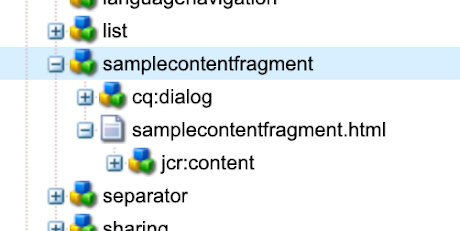Using AEM core components
Using Custom Sling Model
Using Servlet to access Content Fragment.

Let's see how to render Content Fragment using the sling Model.

Create an AEM component "samplecontentfragment" which calls the sling model SampleContentFragment.java
samplecontentfragment.html
<p data-sly-test="${properties.text}">Text property: ${properties.text}</p>
Render Content Fragment using Sling Model
Title: ${model.title}
Description: ${model.description}
Release Date: ${model.releaseDate}
</img>
</sly>
SampleContentFragment.java
package com.adobe.aemquickstart.core.models;
import java.util.Calendar;
import java.util.Optional;
import javax.annotation.PostConstruct;
import javax.inject.Inject;
import org.apache.commons.lang.StringUtils;
import org.apache.sling.api.resource.Resource;
import org.apache.sling.api.resource.ResourceResolver;
import org.apache.sling.models.annotations.DefaultInjectionStrategy;
import org.apache.sling.models.annotations.Model;
import org.apache.sling.models.annotations.injectorspecific.Self;
import com.adobe.cq.dam.cfm.ContentElement;
import com.adobe.cq.dam.cfm.ContentFragment;
import com.adobe.cq.dam.cfm.FragmentData;
import com.adobe.cq.dam.cfm.FragmentTemplate;
@Model(adaptables = Resource.class, defaultInjectionStrategy = DefaultInjectionStrategy.OPTIONAL)
public class SampleContentFragment {
public static final String MODEL_TITLE = "AEM Book";
public static final String CF_PATH = "/content/dam/aemquickstart/content-fragments/aem-book";
@Inject
@Self
private Resource resource;
@Inject
ResourceResolver resourceResolver;
private Optional<ContentFragment> contentFragment;
@PostConstruct
public void init() {
Resource fragmentResource = resourceResolver.getResource(CF_PATH);
contentFragment = Optional.ofNullable(fragmentResource.adaptTo(ContentFragment.class));
}
public String getTitle() {
return contentFragment.map(cf -> cf.getElement("title")).map(ContentElement::getContent)
.orElse(StringUtils.EMPTY);
}
public String getDescription() {
return contentFragment.map(cf -> cf.getElement("description")).map(ContentElement::getContent)
.orElse(StringUtils.EMPTY);
}
public Calendar getReleaseDate() {
return ((Calendar) contentFragment.map(cf -> cf.getElement("releaseDate")).map(ContentElement::getValue)
.map(FragmentData::getValue).orElse(StringUtils.EMPTY));
}
public String getImage() {
return contentFragment.map(cf -> cf.getElement("image")).map(ContentElement::getContent)
.orElse(StringUtils.EMPTY);
}
}
Add the new component on to the page and refresh the page.

<p data-sly-test="${properties.text}">Text property: ${properties.text}</p>
Render Content Fragment using Sling Model
Title: ${model.title}
Description: ${model.description}
Release Date: ${model.releaseDate}
</img>
</sly>
SampleContentFragment.java
package com.adobe.aemquickstart.core.models;
import java.util.Calendar;
import java.util.Optional;
import javax.annotation.PostConstruct;
import javax.inject.Inject;
import org.apache.commons.lang.StringUtils;
import org.apache.sling.api.resource.Resource;
import org.apache.sling.api.resource.ResourceResolver;
import org.apache.sling.models.annotations.DefaultInjectionStrategy;
import org.apache.sling.models.annotations.Model;
import org.apache.sling.models.annotations.injectorspecific.Self;
import com.adobe.cq.dam.cfm.ContentElement;
import com.adobe.cq.dam.cfm.ContentFragment;
import com.adobe.cq.dam.cfm.FragmentData;
import com.adobe.cq.dam.cfm.FragmentTemplate;
@Model(adaptables = Resource.class, defaultInjectionStrategy = DefaultInjectionStrategy.OPTIONAL)
public class SampleContentFragment {
public static final String MODEL_TITLE = "AEM Book";
public static final String CF_PATH = "/content/dam/aemquickstart/content-fragments/aem-book";
@Inject
@Self
private Resource resource;
@Inject
ResourceResolver resourceResolver;
private Optional<ContentFragment> contentFragment;
@PostConstruct
public void init() {
Resource fragmentResource = resourceResolver.getResource(CF_PATH);
contentFragment = Optional.ofNullable(fragmentResource.adaptTo(ContentFragment.class));
}
public String getTitle() {
return contentFragment.map(cf -> cf.getElement("title")).map(ContentElement::getContent)
.orElse(StringUtils.EMPTY);
}
public String getDescription() {
return contentFragment.map(cf -> cf.getElement("description")).map(ContentElement::getContent)
.orElse(StringUtils.EMPTY);
}
public Calendar getReleaseDate() {
return ((Calendar) contentFragment.map(cf -> cf.getElement("releaseDate")).map(ContentElement::getValue)
.map(FragmentData::getValue).orElse(StringUtils.EMPTY));
}
public String getImage() {
return contentFragment.map(cf -> cf.getElement("image")).map(ContentElement::getContent)
.orElse(StringUtils.EMPTY);
}
}
Add the new component on to the page and refresh the page.

No comments:
Post a Comment
If you have any doubts or questions, please let us know.